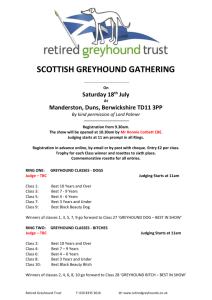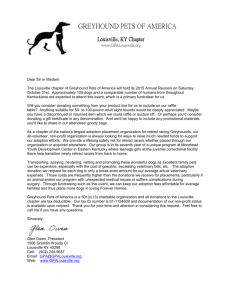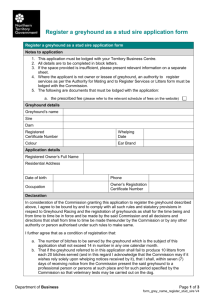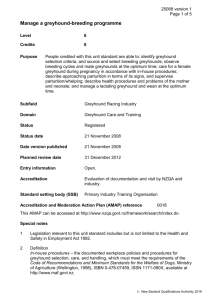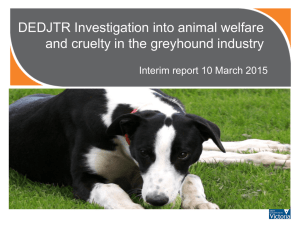Greyhound Bus Lines
advertisement
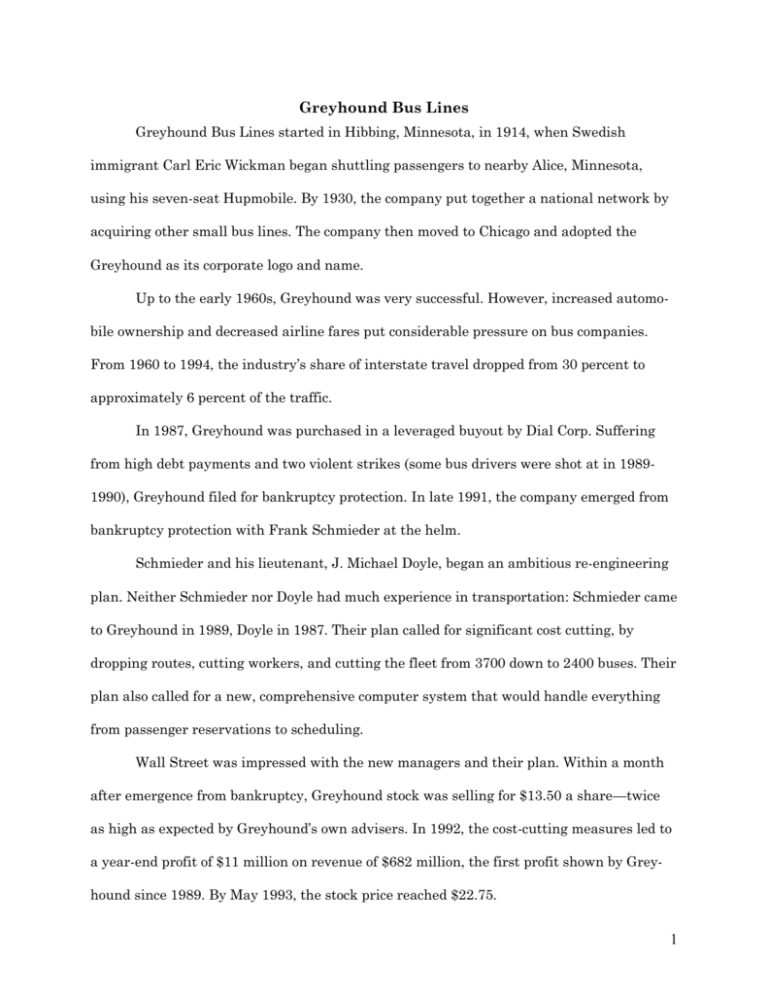
Greyhound Bus Lines Greyhound Bus Lines started in Hibbing, Minnesota, in 1914, when Swedish immigrant Carl Eric Wickman began shuttling passengers to nearby Alice, Minnesota, using his seven-seat Hupmobile. By 1930, the company put together a national network by acquiring other small bus lines. The company then moved to Chicago and adopted the Greyhound as its corporate logo and name. Up to the early 1960s, Greyhound was very successful. However, increased automobile ownership and decreased airline fares put considerable pressure on bus companies. From 1960 to 1994, the industry’s share of interstate travel dropped from 30 percent to approximately 6 percent of the traffic. In 1987, Greyhound was purchased in a leveraged buyout by Dial Corp. Suffering from high debt payments and two violent strikes (some bus drivers were shot at in 19891990), Greyhound filed for bankruptcy protection. In late 1991, the company emerged from bankruptcy protection with Frank Schmieder at the helm. Schmieder and his lieutenant, J. Michael Doyle, began an ambitious re-engineering plan. Neither Schmieder nor Doyle had much experience in transportation: Schmieder came to Greyhound in 1989, Doyle in 1987. Their plan called for significant cost cutting, by dropping routes, cutting workers, and cutting the fleet from 3700 down to 2400 buses. Their plan also called for a new, comprehensive computer system that would handle everything from passenger reservations to scheduling. Wall Street was impressed with the new managers and their plan. Within a month after emergence from bankruptcy, Greyhound stock was selling for $13.50 a share—twice as high as expected by Greyhound’s own advisers. In 1992, the cost-cutting measures led to a year-end profit of $11 million on revenue of $682 million, the first profit shown by Greyhound since 1989. By May 1993, the stock price reached $22.75. 1 Discord at Headquarters Life at Greyhound during the years from 1991 to 1994 was schizophrenic, depending on where you looked. Until Schmieder, Greyhound headquarters were in a Dallas high-rise, near the bus terminal. The offices were spartan and filled with bus memorabilia. Schmieder moved the company to an upscale building in the suburbs. He hired an interior-design firm, paying it as much as $90,000 a month. Decorating costs included $50,000 of fixtures, custom cabinets, and $4500 for two chairs in Doyle’s office. Company funds also paid for season tickets to the Dallas professional sports teams. The executives also flew first-class and stayed at expensive resorts. There were also monthly bills for consulting firms and executive-search firms. One bill from Bain & Co. ran to $175,000 a month. Schmieder also arranged two “communication breakthrough” seminars with the Meridian Institute for $560,000. Few lower-level managers were invited to participate in these sessions, and even headquarters workers scoffed at the calls for teamwork and customer service that began appearing in the corporate newsletter. In two years, Schmieder’s salary rose 57 percent to $526,000, and Doyle’s by 65 percent to $264,000. In the meantime, workers throughout the company were squeezed by the cutbacks. At corporate headquarters, employees scrounged vacant offices for supplies. Mr. Oller, a marketing manager who worked for Greyhound for six months in 1992, observes that “There were never-ending meetings about who was going to get fired.” Several other corporate employees lasted a year or less. In the field, experienced managers were routinely sacked to cut costs. Most of the terminals were staffed with parttime workers and “customer-service associates.” These employees earned $6 an hour regardless of their jobs, with little or no chance for a raise. Few of them had completed high school. Turnover at some terminals ran 100 percent a year and 30 percent was common. Ralph Borland, a long-time Greyhound manager working as vice-president for customer 2 satisfaction, notes that the turnover rate did not bother Greyhound management, since “If people stayed around too long, they would get too sour and cynical.” When touring facilities, customer-service executives were “shocked” to find terminal workers making fun of customers and ignoring others. Ridership was falling. To cut costs further, the number of buses and drivers was cut (down by half since the mid-1980s) and routes were rescheduled. Bus drivers began complaining that they had to exceed speed limits to meet the new schedules. A New Information System When Greyhound was the market leader and millions of people rode the buses, there was little need for a comprehensive information system. The company set basic schedules and sold tickets at the station. If demand was high, the company simply added more buses and drivers. If buses ran half-empty, it did not matter, because margins were high enough to cover the costs. With tight margins and a push for efficiency, Greyhound managers needed better data. Existing ridership data was often months old; the company needed a system to track ridership, plan schedules, and identify where it was necessary to cut prices to compete. Management also wanted to be able to sell tickets in advance, enabling customers to reserve seats. Elements of the proposed system are similar to the issues faced by the airline reservation systems. In some ways, the Greyhound system would be simpler, because reservations and tickets would be sold only through existing terminals, or through a tollfree phone number. The airline reservation systems provide additional support to travel agents. On the other hand, a bus trip is considerably different from an airline flight. An airline passenger traveling coast-to-coast might make one stop. A coast-to-coast bus trip would probably make 10 or more stops. Each leg of the trip would carry slightly different 3 travelers, as some got on and off at intermediate destinations. Greyhound systems analysts estimated they would have to handle as many as 1800 vehicle stops a day, more than 10 times as many as an airline system. Greyhound management assigned about 40 full-time people to develop the new Trips reservation system. They were given a $6 million budget and slightly over a year to develop the system. Systemwide rollout was planned for the summer of 1993. Thomas Thompson, senior vice-president for network planning and operations, notes that “Every bone in my body knew that we were starting a very difficult undertaking.” A First Attempt The base software for Trips was written by an outside firm. The system was a nightmare. It required 40 hours of training for station clerks. Even then, the screens were cluttered and disorganized, often requiring several screens and options to book a simple ticket. The system also did not include all of the Greyhound destinations, so clerks often had to resort to the old log books to write tickets. Greyhound tested the system in Houston, Dallas, San Antonio, and Austin during the 1992 Christmas season. The system crashed repeatedly, and it took twice as long to issue a ticket with Trips as it did manually. In an executive meeting in February 1993, Thompson suggested that the system needed to be redesigned from scratch. He also suggested that the planned summer 1993 implementation be delayed. But Doyle reportedly ruled out any discussion of delays, declaring that “We made these commitments, and, by God, we’re going to live up to them.” Thompson now believes that he should have pressed harder for a delay or that he should have quit the company. Instead, he kept on, and all notes and references to his comments were destroyed. Doyle denies that he destroyed documents or fought against the decision, claiming that the designer team made the decision to continue. 4 In April 1993, Greyhound executives made public promises that the reservation system would be operational by the summer. They also filed with the SEC for a public offering of an additional 4 million shares of stock. The prospectus promised that the Trips system would make it easier to purchase tickets, reserve space and improve customer service. An unnamed executive comments on the internal climate, noting that My clear impression was that as long as we could have some form of reservation system—as long as we could just book one reservation somewhere—then by some means, we would be living up to our obligations. Through June 1993, the team continued to revise the software. They also installed the system in additional terminals. At the end of May, it was running at 50 locations. However, computer terminals routinely froze up. The company also changed its longdistance phone carrier and established a toll-free phone number for reservations. In June, technicians were seriously considering delaying system when Doyle walked into a meeting and said the idea was not to be discussed. In July, the board of directors was told that Trips was ready to go. Announcement of an increase in second-quarter earnings and strong ridership numbers resulted in a 4.5 percent increase in the stock price. Rollout On July 27, Greyhound activated the toll-free number service, which was to book reservations through the now-200 terminals connected to Trips. The Omaha, Nebraska service had 400 agents selling tickets, in addition to the agents at the terminals. Systems designers were uncertain about what to expect, except they believed the system would not work. It did not. The new phone lines handled 800,000 calls a day (up from a traditional 60,000). Many of them were repeated attempts by customers to get through—callers often tried a dozen times to reach the ticket agents. 5 The computers in Dallas were swamped. Ticket agents sometimes had to wait 45 seconds for the computer to respond to a single keystroke. It often took five minutes to print a ticket. The system crashed so often that agents resorted to writing tickets by hand. At some terminals, passengers were told to stand in line so that their tickets could be reissued by computer. Passengers missed connections, were separated from their luggage, and often had to sleep in the terminals. At the New York Port Authority building, competing regional bus lines called in extra buses and lured away passengers. By September, technicians pulled the plug on reservations west of the Mississippi river. On at least one weekend, they told the Omaha center not to take any more reservations. Somewhat surprisingly, none of this news seemed to reach analysts on Wall Street (of course, most of them travel by air). On August 4, Greyhound stock was trading at $21.75 a share—that’s when Doyle decided to sell 15,000 shares that he had purchased with options for $9.81 a share. In the first two weeks of August, Schmieder also exercised options and sold 13,600 shares for a profit of $155,000. On September 23, almost two months after the introduction of the Trips system, Greyhound announced that ridership fell 12 percent in August and that earnings would not meet the early forecasts. Greyhound stock fell to $11.75 a share in a single day. Thompson was removed as head of the Trips development team. His successor lasted only until January 1994. In May 1994, the Trips system caused problems again. Hoping to gain riders, Greyhound offered a $68 fare for any trip in the United States with a three-day advance purchase. The price attracted thousands of customers. The Trips system crashed again. With too few buses and drivers, terminals were packed with angry customers. Agents simply stopped selling tickets. 6 In the first half of 1994, Greyhound’s operating revenue plummeted 12.6 percent, with a net loss of $61.4 million ($4.19 a share). Meanwhile, the nine largest regional carriers in the nation showed increased operating revenue of 2.2 percent. In July 1994, Schmieder announced that Greyhound would abandon the long-haul business on concentrate on shorter routes. Three weeks later, he was forced to resign. Doyle also resigned. Shareholders filed suits alleging that Greyhound’s public statements miscommunicated the status of the company. We Can’t Quit Now In January 1994, Greyhound hired Bradley Harslem, a former American Airlines reservations executive, as chief information officer to oversee the Trips system and solve its problems. In late 1994, the revised system was running at 248 locations. Training time was reduced to 16 hours, but even Harslem sometimes has trouble using the system. The system is finally beginning to produce ridership data to assist managers in planning and scheduling. However, it still could not guarantee a passenger a seat on the bus. Case Questions 1. List all of the things that Greyhound did wrong. 2. What were the primary causes of the problems? 3. If you were running Greyhound, what could you have done differently to prevent or minimize the problems? 4. Because no one can change the past, what would you suggest Greyhound do now to solve its problems? Additional Reading Tomsho, Robert, 1994, How Greyhound Lines re-engineered itself right into a deep hole, Wall Street Journal, 10/20/94, p. A1, A4. The productive keep producing, Information Week, 8/18/95. Cristina B. Sullivan, Surveying the lay of the LAN: inventory tools help IS keep track of what's on networked nodes, PC Week, August 14, 1995, pp. N3-N5. 7 David Stodder, The database knows, LAN Magazine, May 1995, pp. S37-S42. Parallel ports learn new tricks, Windows Magazine, 4/95. 8

